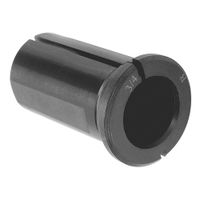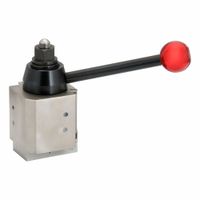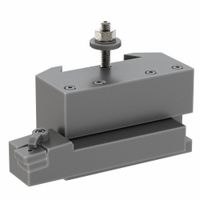Call +(254) 703 030 000 / 751 483 999 / 721 704 777
- Home
- Machining
- Toolholding Tooling Systems
- Lathe Tool Posts Tool Post Holders
.....Read More
Frequently Asked Questions
What are the different types of lathe tool posts?
The different types of lathe tool posts include:
1. **Single Tool Post**: This is the simplest type, designed to hold one cutting tool at a time. It is commonly used in basic operations and is manually adjusted.
2. **Four-Way Tool Post**: This type allows for four different tools to be mounted simultaneously. The post can be rotated to bring the desired tool into position, enhancing efficiency by reducing tool change time.
3. **Quick Change Tool Post (QCTP)**: Known for its versatility and efficiency, the QCTP allows for rapid tool changes. It consists of a main post and interchangeable tool holders, which can be swapped quickly without losing alignment.
4. **Turret Tool Post**: This type features a rotating turret that can hold multiple tools. It is ideal for repetitive operations, as it allows for quick indexing of tools, reducing downtime.
5. **Multifix Tool Post**: Similar to the QCTP, the Multifix system offers a wide range of tool positions and angles, providing flexibility and precision. It is favored for its rigidity and repeatability.
6. **Compound Rest Tool Post**: This is an integral part of the compound rest assembly, allowing for angular adjustments of the tool. It is used for taper turning and other operations requiring precise angular positioning.
7. **Gang Tool Post**: Used primarily in CNC lathes, this setup involves mounting multiple tools in a row on a single block. It is efficient for high-volume production, as it minimizes tool change time.
Each type of tool post is designed to meet specific machining needs, balancing factors like speed, precision, and ease of use.
How do I choose the right tool post holder for my lathe?
To choose the right tool post holder for your lathe, consider the following factors:
1. **Lathe Size and Capacity**: Match the tool post holder to the size and capacity of your lathe. Ensure it can handle the tool sizes and types you plan to use.
2. **Type of Tool Post Holder**: Decide between a quick-change tool post (QCTP) or a traditional four-way tool post. QCTPs offer faster tool changes and versatility, while four-way posts are more rigid and cost-effective.
3. **Tool Post Size**: Ensure the tool post holder fits your lathe's compound rest. Common sizes include AXA, BXA, and CXA, which correspond to different lathe swing sizes.
4. **Material and Construction**: Choose a tool post holder made from durable materials like hardened steel or cast iron for longevity and stability.
5. **Compatibility with Tooling**: Ensure the holder is compatible with the tooling you use, such as turning, facing, or boring tools. Check the shank size and type.
6. **Ease of Use**: Consider how easy it is to adjust and change tools. A QCTP allows for quick adjustments, which is beneficial for frequent tool changes.
7. **Precision and Stability**: Look for a holder that provides precision and stability during operations to ensure accurate machining.
8. **Budget**: Balance your needs with your budget. While QCTPs are more expensive, they offer greater flexibility and efficiency.
9. **Brand and Reviews**: Consider reputable brands and read reviews to ensure reliability and performance.
10. **Future Needs**: Anticipate future projects and choose a holder that can accommodate potential upgrades or different tooling requirements.
By evaluating these factors, you can select a tool post holder that enhances your lathe's performance and meets your machining needs.
What is the purpose of a quick-change tool post?
A quick-change tool post is a device used in machining operations, particularly on lathes, to facilitate the rapid and efficient swapping of cutting tools. Its primary purpose is to enhance productivity and precision in machining processes by minimizing downtime associated with tool changes.
The quick-change tool post allows operators to switch between different tools, such as turning, facing, boring, or threading tools, without the need for time-consuming adjustments or realignment. This is achieved through a system of interchangeable tool holders that can be easily mounted and secured onto the tool post. Each tool holder is pre-set to a specific height and orientation, ensuring consistent tool positioning and reducing the need for recalibration.
By enabling swift tool changes, the quick-change tool post significantly reduces setup time, allowing for more efficient workflow and increased machine utilization. This is particularly beneficial in production environments where multiple operations are performed in sequence, as it minimizes interruptions and maintains the momentum of the machining process.
Additionally, the quick-change tool post contributes to improved accuracy and repeatability. Since the tool holders are pre-set, the risk of human error during tool alignment is minimized, leading to more consistent machining results. This precision is crucial for maintaining tight tolerances and achieving high-quality finishes on machined parts.
Overall, the quick-change tool post is an essential component in modern machining, offering time savings, enhanced precision, and greater flexibility in tool management, ultimately leading to increased productivity and cost-effectiveness in manufacturing operations.
How do I install a tool post on a lathe?
1. **Safety First**: Ensure the lathe is turned off and unplugged. Wear appropriate safety gear.
2. **Remove Existing Tool Post**: If there is an existing tool post, loosen the securing bolts or nuts using a wrench or spanner and remove it from the compound rest.
3. **Clean the Surface**: Clean the compound rest surface to remove any debris or oil, ensuring a flat and stable base for the new tool post.
4. **Select the Tool Post**: Choose the appropriate tool post for your lathe, considering the size and type (e.g., quick-change, turret).
5. **Position the Tool Post**: Place the new tool post on the compound rest. Align it properly with the centerline of the lathe spindle.
6. **Secure the Tool Post**: Insert the securing bolt through the tool post base and into the T-slot or threaded hole on the compound rest. Tighten the bolt using a wrench, ensuring the tool post is firmly attached.
7. **Adjust the Height**: Use shims or an adjustable tool holder to set the tool height to the centerline of the workpiece. This is crucial for accurate machining.
8. **Install Tool Holder**: Attach the tool holder to the tool post. Secure it using the locking mechanism provided, such as a cam lock or set screws.
9. **Align the Tool**: Ensure the cutting tool is aligned correctly with the workpiece. Adjust the angle and position as necessary for the specific operation.
10. **Test the Setup**: Rotate the lathe spindle by hand to ensure there is no interference between the tool and the workpiece. Make any necessary adjustments.
11. **Final Check**: Double-check all bolts and settings to ensure everything is secure before powering on the lathe.
12. **Power On**: Plug in and turn on the lathe, ready for operation.
What materials are tool post holders typically made from?
Tool post holders are typically made from materials that offer a combination of strength, durability, and resistance to wear and tear. Common materials include:
1. **Steel**: Often used due to its high strength and durability. Tool post holders made from steel can withstand significant stress and are suitable for heavy-duty applications. They are usually heat-treated to enhance their hardness and wear resistance.
2. **Cast Iron**: Known for its excellent vibration damping properties, cast iron is used in tool post holders to reduce chatter during machining operations. It is also relatively easy to machine and provides good stability.
3. **Alloy Steel**: This is a variation of steel that includes additional elements such as chromium, vanadium, or molybdenum to improve its mechanical properties. Alloy steel tool post holders offer enhanced toughness and resistance to wear and fatigue.
4. **Aluminum**: Used in applications where weight is a concern, aluminum tool post holders are lighter than steel or cast iron but still provide adequate strength for many machining tasks. They are also resistant to corrosion.
5. **Carbide**: Though less common for the entire tool post holder, carbide inserts or components may be used for their extreme hardness and wear resistance, especially in high-speed or precision applications.
6. **Composite Materials**: In some advanced applications, composite materials may be used to provide a balance of strength, weight, and thermal stability.
These materials are chosen based on the specific requirements of the machining operation, such as the type of material being machined, the speed of operation, and the precision required.
How do I maintain and care for lathe tool posts and holders?
To maintain and care for lathe tool posts and holders, follow these steps:
1. **Regular Cleaning**: After each use, clean the tool post and holders to remove metal shavings, dust, and oil. Use a brush or compressed air for debris and a clean cloth for wiping.
2. **Lubrication**: Apply a light machine oil to moving parts to prevent rust and ensure smooth operation. Focus on the tool post's sliding surfaces and any adjustment screws.
3. **Inspection**: Regularly inspect for wear, damage, or misalignment. Check for cracks, burrs, or any signs of wear that could affect performance.
4. **Alignment**: Ensure the tool post is properly aligned with the lathe's spindle. Misalignment can cause poor cuts and tool wear. Use a dial indicator to check and adjust as necessary.
5. **Tightening**: Ensure all screws and bolts are properly tightened. Loose components can lead to vibration and inaccurate machining.
6. **Storage**: Store tool holders in a dry, clean environment. Use protective covers or cases to prevent dust accumulation and physical damage.
7. **Rust Prevention**: Apply a rust inhibitor or keep a dehumidifier in the storage area to prevent rust, especially in humid environments.
8. **Sharpening**: Regularly sharpen cutting tools to maintain efficiency and reduce stress on the tool post and holders.
9. **Replacement**: Replace any worn or damaged parts immediately to prevent further damage or safety hazards.
10. **Training**: Ensure all operators are trained in proper handling and maintenance procedures to extend the life of the equipment.
By following these steps, you can ensure the longevity and optimal performance of your lathe tool posts and holders.
What are the benefits of using toolholder bushings in CNC lathes?
Toolholder bushings in CNC lathes offer several benefits that enhance machining efficiency and precision:
1. **Versatility**: Toolholder bushings allow the use of a wide range of tool sizes and types in a single machine, increasing the versatility of CNC lathes. This adaptability enables operators to switch between different tools without needing multiple toolholders, saving time and reducing costs.
2. **Precision and Stability**: Bushings provide a snug fit for cutting tools, ensuring they are held securely in place. This stability minimizes tool vibration and runout, leading to improved machining accuracy and surface finish. The precise alignment of tools also reduces the risk of tool breakage and workpiece damage.
3. **Cost-Effectiveness**: By using bushings, manufacturers can reduce the need for purchasing multiple toolholders for different tool sizes. This cost-effective solution allows for the efficient use of existing tools and equipment, optimizing resource allocation.
4. **Quick Changeover**: Toolholder bushings facilitate rapid tool changes, minimizing downtime during production. This quick changeover capability enhances productivity by allowing operators to swiftly switch between different machining operations without extensive setup time.
5. **Extended Tool Life**: The secure fit provided by bushings reduces tool wear and tear by minimizing vibration and movement during machining. This extended tool life results in lower tool replacement costs and consistent machining quality over time.
6. **Improved Safety**: Properly fitted bushings ensure that tools are securely held, reducing the risk of tool ejection during high-speed operations. This safety feature protects both the machine and the operator from potential accidents.
7. **Enhanced Machine Performance**: By maintaining tool alignment and stability, bushings contribute to the overall performance and efficiency of CNC lathes. This enhancement leads to higher quality outputs and increased production rates.
Overall, toolholder bushings are essential components that optimize the functionality and efficiency of CNC lathes, providing significant advantages in precision machining environments.



